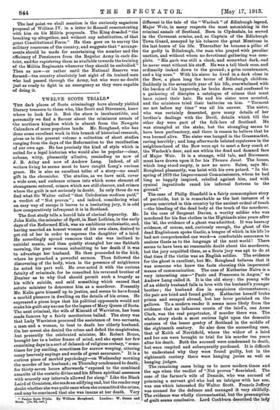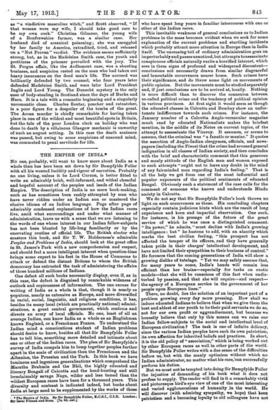TWELVE SCOTS TRIALS.* THE dark places of Scots criminology have
already yielded literary treasure to those who, like Scott and Stevenson, knew where to look for it. But the store is inexhaustible, and personally we find a flavour about the criminous annals of .the northern kingdom which is absent from the Newgate Calendars of more populous lands. Mr. Roughead, who has done some excellent work in this branch of historical research, gives us in the present volume a collection of short studies ranging from the days of the Reformation to the recollection of our own age. He has precisely the kind of style which is suited for a legal historian who would also be popular—clear, urbane, witty, pleasantly allusive, reminding us now of .3". B. Atlay and now of Andrew Lang. Indeed, of all writers living he seems most to have caught Lang's curious grace. He is also an excellent teller of a story—no small gift in the chronicler. The studies, as we have said, cover a wide area, and embrace crimes into which some element of strangeness entered, crimes which are still obscure, and crimes where the guilt is not seriously in doubt. In only three do we find what Sir Walter called "that Caledonian medium quid," a verdict of " Not proven" ; and indeed, considering what an easy way of escape it leaves to a hesitating jury, it is odd bow comparatively infrequent it is in Scotland.
The first study tells a horrid tale of clerical depravity. Mr. John Kello, the minister of Spott, in East Lothian, in the early days of the Reformed Kirk, was an ambitious ecclesiastic, and, having married an honest woman of his own class, desired to get rid of her in order to espouse the daughter of a laird. He accordingly spread rumours that she was inclined to suicidal mania, and then quietly strangled her one Sabbath morning, the poor woman submitting to her death if it was to advantage her husband. He then proceeded to the kirk, where he preached a powerful sermon. Then followed the discovering of the body, when in the presence of neighbours he acted his part welL He over-acted it with the curious fatuity of criminals, for he consulted his reverend brother of Dunbar as to why God should permit such a tragedy as his wife's suicide, and said something which caused that astute minister to denounce him as a murderer. Presently Mr. Kello gave himself up to justice, and seems to have found a morbid pleasure in dwelling on the details of his crime. He expressed a pious hope that his political opponents would not make his guilt any excuse for the lapses of Mary Queen of Scots. The next criminal, the wife of Kincaid of Warriston, has been made famous by a fairly meritorious ballad. The story was that Lady Warriston procured the assistance of two servants, a man and a woman, to beat to death her elderly husband. On her arrest she denied the crime and defied the magistrates, but presently the celebrated minister, Mr. Robert Bruce, brought her to a better frame of mind, and she spent her few remaining days in a sort of debauch of religious ecstasy, " some- times for joy smiling, sometimes for sorrow weeping, uttering many heavenly sayings and words of great assurance." It is a curious piece of morbid psychology—on Wednesday morning the murder of her husband ; on Thursday condemned to death; for thirty-seven hours afterwards "exposed to the combined assaults of the ecstatic divine and his fifteen spiritual assessors with scarcely any intervals allowed for sleep." Like the Black Laird of 0 rmiston, she made an edifying end, but the reader may doubt whether she was quite sane when she committed the crime, and may be convinced that she was insane at her death. Very
• nosh. Scots Trials. By William Boughead. London: W. Green and Bons. C7s. 6€1. usta different is the tale of the " Warlock " of Edinburgh legend. Major Weir, in many respects the most astonishing in the criminal annals of Scotland. Born in Clydesdale, he served in the Covenant armies, and, as Captain of the Edinburgh Town Guard, annoyed by his tobacco the great Montrose in the last hours of his life. Thereafter he became a pillar of the godly in Edinburgh, the man who prayed with peculiar unction, and without whom no devotional gathering was com- plete. " His garb was still a cloak, and somewhat dark, and he never went without his staff. He was a tall black man, and ordinarily looked down to the ground; a grim countenance, and a big nose." With his sister he lived in .a dark close in the Bow, a place long the terror of Edinburgh children. Suddenly in the seventieth year of his life, overwhelmed with the burden of his hypocrisy, he broke down and confessed to a gathering of disciples a catalogue of crimes that, must have raised their hair. He and his sister were arrested, and the ministers tried their batteries on him. " Torment me not before my time " was all his answer. The sister, who was certainly demented, gave many details of her brother's dealings with the Devil, details which till the other day were part of the folk-lore of Scotland. He was strangled at the stake, but the strangling seems to have been perfunctory, and there is reason to believe that he was burned alive. The sister was hanged in the Grassmarket, raving horribly ; and long afterwards belated roysterers in the neighbourhood of the Bow were apt to meet a fiery coach at the Warlock's door, and see within the dead and damned face of Major Weir. It is a strange, wild tale, and Stevenson must have drawn upon it for his Thrawn Janet. The house, which long stood empty, is now no more. Satan, says Mr. Roughead pleasantly, was hoist with his own petard. "In the spring of 1878 the Improvement Commissioners, whom he had long so happily inspired, rebelled against him, and with cynical ingratitude razed his infernal fortress to the ground."
The case of Philip Stanfield is a fairly commonplace story of parricide, but it is remarkable as the last instance of a person convicted in this country by the ancient ordeal of touch —the bleeding of the dead body at the touch of the murderer. In the case of Sergeant Davies, a worthy soldier who was murdered for his fine clothes in the Highlands nine years after the '45, the evidence of a ghost was admitted. It was hearsay evidence, of course, and, curiously enough, the ghost of the dead Englishman spoke Gaelic, a tongue of which in his life he had not comprehended one word—a comfortable assurance to zealous Gaels as to the language of the next world ! There seems to have been no reasonable doubt about the murderers, but the jury acquitted them, as a Scots jury was apt to do at that time if the victim was an English soldier. The evidence for the ghost is excellent, but Mr. Roughead believes that it was someone who knew the facts choosing this impersonal means of communication. The case of Katharine Nairn is a very interesting one—" Paolo and Francesca in Angus," as Andrew Lang called it. It is the old story : the young wife of an elderly husband falls in love with the husband's younger brother ; the husband dies in suspicious circumstances ; the pair are tried and found guilty. Katharine herself broke prison and escaped abroad, but her lover perished on the gallows. To a modern reader it seems more likely from the evidence that an infamous cousin of the laird's, one Anne Clark, was the real perpetrator, if murder there was. The whole story sheds a most curious light upon the domestic customs of the lesser gentry of Scotland in the middle of the eighteenth century. So also does the succeeding case, that of Keith of Northfield, where the widow of a laird and her son were brought to trial for his murder ten years after his death. Both the accused were condemned to death, but were respited and subsequently pardoned. It is difficult to understand why they were found guilty, but in the eighteenth century there were hanging juries as well as hanging judges.
The remaining cases bring us to more modern times and the age when the verdict of "Not proven" flourished. The case of the farmer's wife of Denside, who was accused of poisoning a servant girl who had an intrigue with her son, was one which interested Sir Walter Scott. Francis Jeffrey
was counsel for the defence and managed it very skilfully. The evidence was wholly circumstantial, but the presumption of guilt seems conclusive. Lord Cockburn described the lady as '" a vindictive masculine witch," and Scott obserred, " If that woman were my wife, I should take good care to be my own cook." Christina Gilmour, the young wife of a Renfrewehire farmer, was a similar case. Her husband died of arsenical poisoning ; she was smuggled by her family to America, extradited, tried, and released .on a "Not Proven" verdict. The evidence seems sufficiently strong, but, as in the Madeleine Smith case, the youth and prettiness of the prisoner prevailed with the jury. The St. Fergus affair, like the Ardlamont case, was a shooting 'business, and suspicion rested on the man who had taken out heavy insurances on the dead man's life. The accused was brilliantly defended by two counsel, who four years later defended Madeleine Smith, and were later Lord President Inglis and Lord Young. The Dunecht mystery is the only ease of body-stealing in Scotland since the days of Burke and Hare. It is a tale with a romantic beginning and a singularly unromantic close. Charles Soutar, poacher and ratcatcher, is a poor figure for a despoiler of the tombs of the great. The Arran murder is chiefly remarkable fcr having taken place in one of the wildest and most beautiful spots in Britain, but the tale of the poor London clerk on holiday who was done to death by a villainous Glasgow mechanic is unworthy of such an august setting. In this case the death sentence was passed, but owing to some suspicions of unsound mind, was commuted to penal servitude for life.











































 Previous page
Previous page